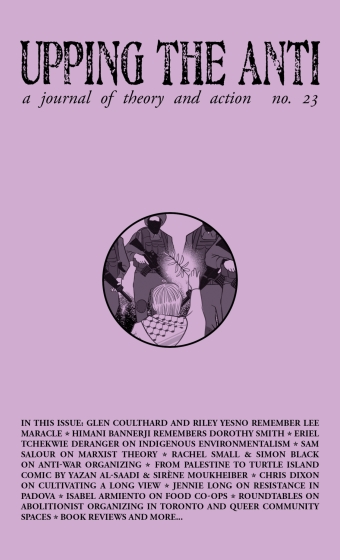The Cognitive and Territorial Defense of Native Peoples
The lack of recognition of native communities in the sphere of Mexican politics remains a devastating topic. I regret starting like this, but it is right and necessary. Sadly, this is the only thing I could think of while reading the conversation between Alejandro Franco Briones and Yásnaya A. Gil in “The Defense of Cognitive and Actual Territories” in Issue 22 of Upping the Anti.
This interview presented a very reasonable perspective, it emphasized the horrors that minoritized people have been put through in the past, and what they continue to endure in the present. I want to reiterate the intentionality of these horrors. It is not a historic accident that some people are considered a minority rather than others. However, it is also necessary to talk of the struggles of native communities from their own perspective: with a burning urgency and as a belligerent force against the colonial order, rather than as victims.
I remember that a couple of years ago Alejandro posted on social media about his participation in an ilustratón organized for #AguaParaAyutla. By stroke of luck, we shared social media spaces and found ourselves in a place of convergent thinking. I participated in an online session organized via Estuary, an open source coding platform, generating imagery and animation with political messages that would help to make visible the issue of dispossession of groundwater reserves and, hopefully, contribute to its resolution.
Sadly, there has been little progress made on the issue, and there is still a lot not known about it. But it seems to be that we have achieved one thing: we’ve raised awareness about the unsustainability of ancestral territories.
The problem is clear, especially because the state shamelessly and repeatedly evades their responsibility and obligation. The water issue in Ayutla Mixe (Oaxaca) is the result of an armed invasion by the Mexican state and the federal police on communities, not a conflict between two Mixe communities for a natural resource such as water.
Logically, it makes no sense that a community would destroy a water storage system that it has worked for three decades to develop to dispossess themselves of a vital resource they require to remain.
There is an excess of contradictions and the deeds are in the words. What I mean is that words end up reproducing the actions of the state in its genocidal project. Words like “mestizo,” “Indigenous,” and “multicultural” reproduce the ways of thinking and acting of this organism of tremendous power. Let us demystify some equivocal, inexact, and extremely painful ideologies for groups that have been defined in these terms.
It is a state imposition to say that the category “Indigenous” is cultural. Considering that during colonial times they were called “Indians” but during the 19th century the concept was substituted by “Indigenous,” in believing that the change of the concept signifies national progress, we would err by reproducing this way of thinking because they are deceptive categories that only seek to homogenize cultural and linguistic diversity.
Far from fitting everything in the same mould, communities must understand each other by their differences, since each group that forms them has distinct characteristics: they don’t share cosmologies, music, epistemes, ways of governing, or customs and practices.
For this reason, it is important to realize that Mixes, Mazatecos, Huicholes, are not Indigenous because they don’t belong historically or culturally to the same group. They are not a homogenous whole. These groups have spent more time being ayuuk and chjota énna and wixárika than what they have spent being “Indians” or “Indigenous,” which are cultural categories in the discourse of multiculturalism, but in reality are political terms. 1
However, there is always hope. The state must recognize the communities’ freedom for self-determination and self-government. But above all, the Mexican state must eradicate the liberal narrative of multiculturalism to clear the way for native communities to produce their own varied imaginaries based on non-hegemonic ideas.
Let’s stand for all the spaces where minoritized peoples exist: their language, their territory, their thought, their life.
Notes

